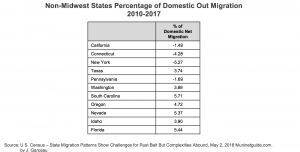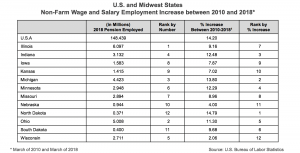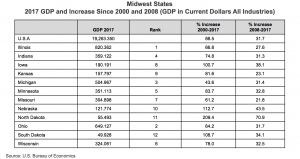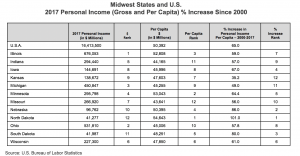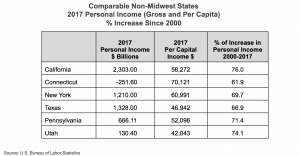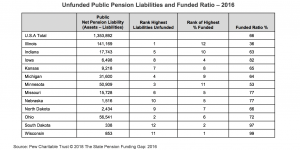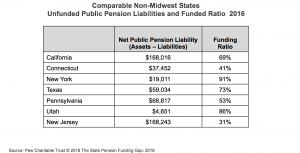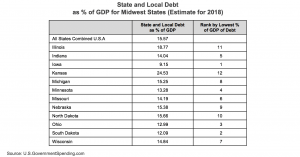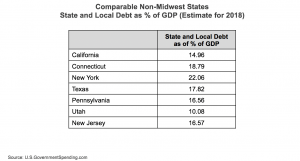By James E. Spiotto
This is Part 2 in a 4-part article series on the Post-Fiscal Crisis State and the next fiscal crisis considerations. The information and charts come from a presentation given at the Government Finance Research Center’s conference entitled “Ready or Not? Post-Fiscal Crisis/Next Fiscal Crisis” held on May 2-3, 2019 at the Federal Reserve Bank of Chicago.
To read part 1 click here.
The Comparison of key economic factors of Illinois and Chicago demonstrate the Good, the Bad and the not so pretty. Slower population, employment, personal income and GDP growth since 2000 can be reversed. While the larger reduction of unemployment in the Midwest generally and Illinois in particular should be encouraged to improve. While pension liabilities and debt to GDP ratios have led to some credit rating downgrades there is the improving jobs numbers and resulting increase in taxpayers and tax receipts that can shine light on the path forward.
Population growth of Midwest states and the U.S.:
The U.S. between 2000 and 2017 experienced population growth of 15.4% to 325.7 million. Only one Midwest state grew between 2000 and 2017 faster than the U.S. average of 15.4%, namely: North Dakota at 17.6% for obvious reason of energy production. Only four states in the Midwest grew over 10.0% between 2000 and 2017, namely: North Dakota (17.6%), South Dakota (14.9%), Minnesota (13.0%) and Nebraska (12.0%). Another five states in the Midwest grew between 5-10% during the period of 2000 and 2017, namely: Indiana (9.4%), Missouri (9.0%), Kansas (8.1%), Wisconsin (7.8%) and Iowa (7.3%). Three of the Midwest states grew less than 5.0% between 2000 and 2017, namely: Illinois (2.9%), Ohio (2.5%) and Michigan (1.0%). This is less than 20.0% of the U.S. average population growth rate for the period.
Other non-Midwest states grew faster than Midwest states such as Texas (40.5%), Utah (38.1%), Florida (31.2%) and Arizona (36.7%). Between 1990 and 2000, the U.S. population grew by 13.2% but no Midwest state equaled or exceeded that percentage of growth. The highest was Minnesota at 12.4% followed by Wisconsin at 9.6%, Indiana at 9.7%, Missouri at 9.3% and Illinois at 8.6%. With the exception of North Dakota and South Dakota, the Midwest states had negative net domestic migration where more people left the state than those who migrated to that Midwest state with Illinois, Kansas, Michigan and Wisconsin leading the way in loss in domestic migration. Illinois (-5.0%) was second only to New York (-5.25%) in negative domestic migration.
Employment and unemployment in Illinois and the Midwest states compared to U.S. average:
Between March 2010 and March 2018, the number of non-farm wage and salary employment (workers) increased on average in the U.S. by 14.2%. Only one Midwest state equaled or exceed that, namely North Dakota at 14.7%. Only five out of twelve Midwest states had increases in workers employed between March 2010 and March 2018 by more than 10.0%, namely: North Dakota (14.79%), Michigan (13.8%), Indiana (12.48%), Minnesota (12.29%) and Ohio (11.30)%.
During the same time period, March 2010 to March 2018, the U.S. unemployment percentage went from 9.9% to 4.1% in March 2018 or a percentage of unemployment reduction of 58.6% for U.S. Six of the twelve Midwest states including Illinois had a larger percentage of unemployment reduction than the U.S. average, namely: Wisconsin at 68.2%, Michigan at 65.2%, Illinois at 63.9%, Missouri at 62.9%, Ohio at 59.7% and Indiana at 58.9%. But in the Midwest, Illinois was 7th out of 12 in the percentage of employment increase between 2010-2018 and Illinois’ 9.16% increase during that period was less than the U.S. average of 14.20%.
There was slower employment growth between 2010 and 2018 in Illinois (9.16%) and most Midwestern states for the last eight years compared to U.S. average (14.2%), but generally there was an average reduction in unemployment. Employment in the Midwest states grew between March 2010 and March 2018 slower than the average for U.S. states at 14.7%, namely one state was about equal to the average and five states between 14.5% and 10.0%. The remaining of the Midwest states were below 10.0% growth in employment during that period.
There was a larger reduction of unemployed rates between 2010 and 2018 for Illinois (63.9%) and a number of Midwest states as compared to the U.S. average (58.6%). At the same time during the same period of March 2010 to March 2018, six out of twelve Midwest states had their unemployment rate reduced greater than the U.S. average of 58.6%.
Midwestern states GDP and increase in GDP since 2008 and 2000 compared to U.S. combined:
The U.S. Gross Domestic Product in current dollars all industries (“GDP”) in 2017 was $19.263 trillion and it increased since 2000 by 88.5% and since 2008 by 31.7%. Only four Midwest states had a GDP increase equal or more than the U.S. combined GDP increase between 2000 and 2017, namely: North Dakota (209.4%), Nebraska (112.7%), South Dakota (108.7%) and Iowa (110.7%). Seven Midwestern states (including Illinois) had a GDP increase between 2000 and 2017 of over 50.0%, but less than 88.5% U.S. combined, namely: Minnesota (83.7%), Kansas (81.6%), Wisconsin (78.0%), Indiana (74.8%), Illinois (66.8%), Ohio (64.2%) and Missouri (61.2%). Only one state had a GDP increase between 2000 and 2017 of less than 50.0%, namely Michigan at 43.6%.
Midwest states comparison of personal income (per capita income) and percentage increase since 2000 compared to U.S. average for states:
Only four Midwestern states had an increase in per capita personal income equal or greater than the U.S. average increase in per capita personal income between 2000 and 2017 of 65%, namely: North Dakota (101%), South Dakota (80%), Nebraska (86%) and Iowa (67%). Six Midwestern (including Illinois) states had an increase in per capita personal income between 2000 and 2017 of over 50.0% but less than 65.0%, namely: Minnesota (64.4%), Wisconsin (61.0%), Illinois (59.0%), Ohio (57.8%), Indiana (57.0%) and Missouri (56.0%). Two Midwestern states had a per capita personal income increase between 2000 and 2017 of less than 50.0%, namely: Michigan (49.0%) and Kansas (35.2%). The non-Midwestern states had many examples of the increase in per capita personal income between 2000-2017 for the state exceeding the U.S. combined average of 65.0%,namely: California (76.0%), New York (69.7%), Texas (66.8%), Utah (74.1%), and Pennsylvania (71.4%)
Midwestern states comparison of unfunded public pension liabilities and funded ratio for 2016 and other state comparables:
The U.S. average for states of funded ratio for public pension funds is 66% and there are seven Midwest states that equal or exceed that, namely: Wisconsin (99%), South Dakota (97%), Nebraska (89%), Iowa (82%), Missouri (77%), Ohio (72%) and North Dakota (66%). There are five Midwest states (with Illinois being the lowest) that have funding ratios below the average for U.S. states of 66%, namely: Kansas (65%), Michigan (64%), Indiana (63%), Minnesota (53%) and Illinois (36%). Other states that have been used as comparables demonstrate the similar range of funding levels, namely: New York (91%), Utah (86%), Texas (73%), California (69%), Pennsylvania (53%), Connecticut (41%) and New Jersey (31%).
Only three Midwestern states (including Illinois) have state and local debt as a percentage of GDP greater than the average for the combined U.S. state and local debt as percentage of GDP:
The average of U.S. states and local debt as a percentage of GDP is 15.57% and only three Midwestern states have a percentage of debt to GDP that is higher, namely: Kansas (24.53%), Illinois (18.77%) and North Dakota (15.66%). The other non-Midwest state comparables that have been referred to demonstrate similar range of debt as a percentage of GDP with only two states below the U.S. state average, namely: California (14.96%) and Utah (10.08%), and others above New York (22.06%), Connecticut (18.79%), Texas (17.82%), Pennsylvania (16.56%) and New Jersey (16.57%).
Summary of result of analysis of economic and debt factors:
1. Slower population growth between 2000-2017 in Illinois (2.9%) and most Midwestern states than U.S. average (15.4%) and more domestic move outs than move ins with Illinois with largest move outs. Generally Midwest states’ population has grown at a slower pace than the U.S. state average with three states’ population growing less than 20.0% of the U.S. state average, namely: Illinois, Ohio and Michigan. With the exception of North Dakota and South Dakota, the Midwest states had negative net domestic migration (more move outs than move ins).
2. Slower employment growth in Midwestern states for last eight years compared to U.S. average but generally average reduction in unemployment. Employment in the Midwest states grew between March 2010 and March 2018 slower than the average for U.S. states at 14.7%, namely one state was about equal to the average and five states between 14.5% and 10.0%. The remaining of the Midwest states were below 10.0% growth in employment during that period.
3. Larger reduction of unemployed rates for Midwest states. At the same time during the same period of March 2010 to March 2018, six out of twelve Midwest states had their unemployment rate reduced greater than the U.S. average of 58.6%.
4. Slower GDP increase between 2000-2017 for Illinois (66.8%) and some Midwestern states than U.S. average for all states (88.5%). Between 2008 and 2017, four Midwestern states had a GDP increase greater than the U.S. average for all the states and all but one had a GDP increase for the period of greater than 50.0%.
5. Slower personal income increase between 2000-2017 for Illinois (59.0%) than U.S. average (65.0%). Between 2000-2017, per capita personal income for ten out of twelve Midwestern states increased greater than 50.0% and only four Midwest states had per capita personal income increases greater than the U.S. average of 65.0% increase in per capita personal income.
6. Pension liability. Seven out of twelve Midwest states had funded ratio greater than U.S. average of 66.0%, with Wisconsin and North Dakota being virtually fully-funded. But, Illinois was one of the states with the largest unfunded pension liability by dollar and one of the lowest funded ratio.
7. State and local government debt GDP. Only three of the Midwestern states had debt to GDP percentage lower than the U.S. average of 15.57%.
8. Credit rating downgrade. Unfortunately, the State of Illinois’ credit rating has gone from Moody’s Aa3 and S&P and Fitch’s A+ in April of 2010 to Fitch’s BBB, S&P’s BBB- and Moody’s Baa3 in January 2019.
To read part 3 click here.
To read part 4 click here.




